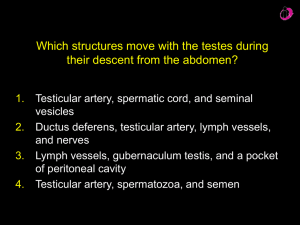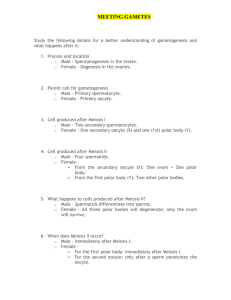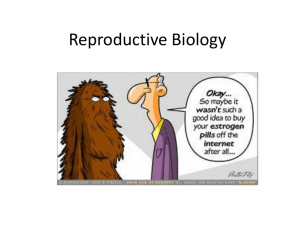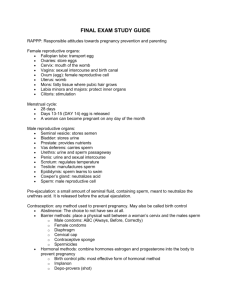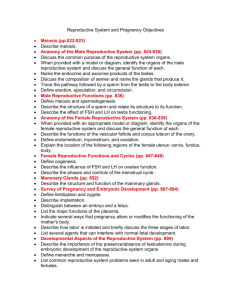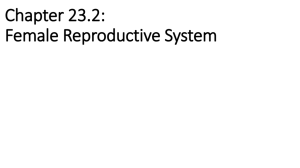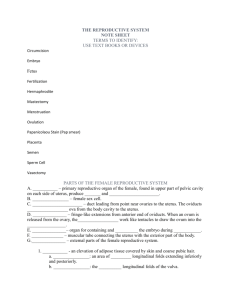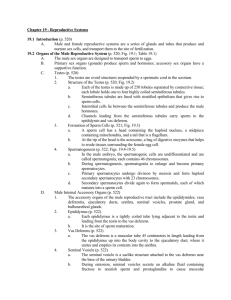Biology 112
advertisement
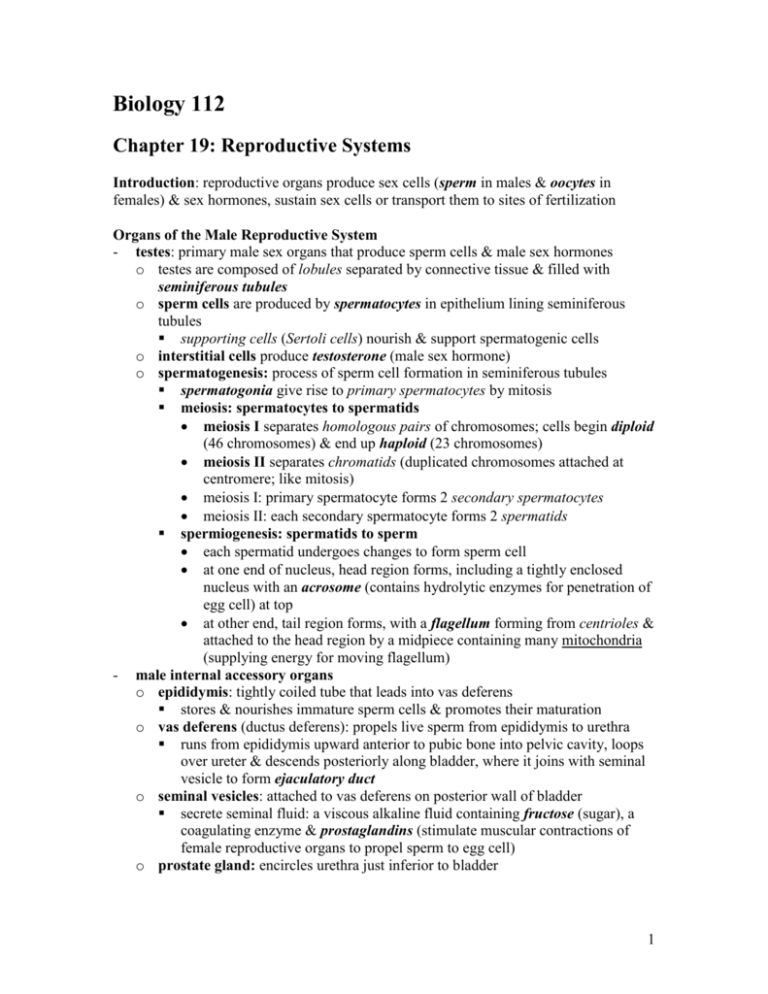
Biology 112 Chapter 19: Reproductive Systems Introduction: reproductive organs produce sex cells (sperm in males & oocytes in females) & sex hormones, sustain sex cells or transport them to sites of fertilization Organs of the Male Reproductive System - testes: primary male sex organs that produce sperm cells & male sex hormones o testes are composed of lobules separated by connective tissue & filled with seminiferous tubules o sperm cells are produced by spermatocytes in epithelium lining seminiferous tubules supporting cells (Sertoli cells) nourish & support spermatogenic cells o interstitial cells produce testosterone (male sex hormone) o spermatogenesis: process of sperm cell formation in seminiferous tubules spermatogonia give rise to primary spermatocytes by mitosis meiosis: spermatocytes to spermatids meiosis I separates homologous pairs of chromosomes; cells begin diploid (46 chromosomes) & end up haploid (23 chromosomes) meiosis II separates chromatids (duplicated chromosomes attached at centromere; like mitosis) meiosis I: primary spermatocyte forms 2 secondary spermatocytes meiosis II: each secondary spermatocyte forms 2 spermatids spermiogenesis: spermatids to sperm each spermatid undergoes changes to form sperm cell at one end of nucleus, head region forms, including a tightly enclosed nucleus with an acrosome (contains hydrolytic enzymes for penetration of egg cell) at top at other end, tail region forms, with a flagellum forming from centrioles & attached to the head region by a midpiece containing many mitochondria (supplying energy for moving flagellum) - male internal accessory organs o epididymis: tightly coiled tube that leads into vas deferens stores & nourishes immature sperm cells & promotes their maturation o vas deferens (ductus deferens): propels live sperm from epididymis to urethra runs from epididymis upward anterior to pubic bone into pelvic cavity, loops over ureter & descends posteriorly along bladder, where it joins with seminal vesicle to form ejaculatory duct o seminal vesicles: attached to vas deferens on posterior wall of bladder secrete seminal fluid: a viscous alkaline fluid containing fructose (sugar), a coagulating enzyme & prostaglandins (stimulate muscular contractions of female reproductive organs to propel sperm to egg cell) o prostate gland: encircles urethra just inferior to bladder 1 - secretes a milky, slightly alkaline fluid containing enzymes & prostatespecific antigen (PSA) that enters prostatic urethra during ejaculation prostate gland hypertrophy affects nearly every elderly male o bulbourethral glands (Cowper’s glands): small glands inferior to prostate gland produce mucus prior to ejaculation that neutralizes acidic urine in urethra o semen: consists of sperm cells & secretions of seminal vesicles, prostate gland & bulbourethral glands slightly alkaline & includes nutrients & prostaglandins male external reproductive organs: o scrotum: sac of skin & fascia that houses testes in left & right compartments temperature of scrotum must be ~ 3C lower than core body temperature for production of viable sperm temperature maintained by contraction & relaxation of dartos & cremaster muscles… contraction pulls scrotum closer to body, increasing temperature, while relaxation allows scrotum to lower, decreasing temperature o penis: copulatory organ; releases sperm produced by testes penis made up of attached root & free body or shaft ending in enlarged tip called glans penis prepuce (foreskin): cuff of skin over penis; may be removed (circumcision) erectile tissue (corpus spongiosum & corpora cavernosum): network of connective tissue & smooth muscle with vascular spaces that become filled with blood during sexual excitement Hormonal Regulation of Male Reproductive Function - Gonadotropin-releasing hormone (GnRH) release from hypothalamus controls release of follicle-stimulating hormone (FSH) & luteinizing hormone (LH) from anterior pituitary - FSH stimulates sustentacular cells to release androgen-binding protein (ABP), which causes spermatogenic cells to bind testosterone & begin spermatogenesis - LH binds to interstitial cells & stimulates them to secrete testosterone - testosterone stimulates development of male reproductive organs and develops & maintains male secondary sex characteristics - testosterone feeds back (negative feedback) to hypothalamus & anterior pituitary, inhibiting release of GnRH & tropic hormones Organs of the Female Reproductive System - ovaries: primary female sex organs that produce oocytes & female sex hormones o outer cortex houses follicles; inner medulla contains blood vessels & nerves o primordial follicles: contain primary oocyte encased by a layer of follicular cells millions formed in cortex during prenatal development begin meiosis during development, but stop midway through meiosis I & don’t continue until puberty number of primary oocytes steadily declines throughout female’s life o oogenesis: ovum formation by meiosis in follicles of ovaries starting at puberty, one follicle is chosen each month to complete meiosis I, resulting in a large secondary oocyte & a small polar body 2 - - the secondary oocyte begins meiosis II, but arrests in metaphase II (awaiting fertilization in oviduct to complete meiosis II); the polar body may divide to form 2 smaller polar bodies the secondary oocyte is ovulated & is picked up by uterine tube; if fertilization occurs, meiosis II is completed, forming the ovum and another polar body the end result of complete oogenesis is 3 small polar bodies & one very large ovum (only the ovum is a functional female gamete); the ovum contains most of the cytosol, with ample nutrients for the 7 day journey to the uterus ovulation: ejection of oocyte from follicle & ovary corpus luteum: structure formed from follicle cells following ovulation; eventually degenerates female internal accessory organs o uterine tubes (fallopian tubes or oviducts): receive ovulated oocyte from ovary & provide site for fertilization ovulated oocyte is cast into peritoneal cavity; cilia of fimbriae sweep oocyte into uterine tube ciliated cells lining tube & peristaltic contractions of smooth muscle in wall of the tube help transport secondary oocyte down uterine tube o uterus: hollow, thick-walled organ in pelvis that receives, retains & nourishes a fertilized ovum consists of fundus, body & cervix from superior to inferior; cervix (neck) projects into vagina uterine wall composed of perimetrium (serous membrane), myometrium (smooth muscle) & endometrium (epithelial tissue) from outside to inside contraction of muscles in myometrium expels baby during childbirth inner lining of endometrium provides site for implantation of embryo; in absence of pregnancy it is shed during uterine cycle o vagina: thin-walled tube extending from cervix to body exterior provides passageway for delivery of baby, for menstrual flow & for delivery of semen (& sperm) to uterine tube urethra is embedded in anterior wall wall consists of outer fibroelastic adventitia, smooth muscle muscularis & mucosa of stratified squamous epithelium with ridges (rugae) female external reproductive organs o labia majora: elongated skin folds running posteriorly from mons pubis & enclosing labia minora o labia minora enclose recess called vestibule, which contains the external opening of urethra (anteriorly) & vagina (posteriorly) o clitoris: small protruding erectile tissue (corpora cavernosa) hooded by prepuce formed by junction of labia minora folds Hormonal Regulation of Ovarian Cycle - GnRH released from hypothalamus stimulates FSH & LH release from anterior pituitary - FSH & LH stimulate follicle growth & estrogen secretion 3 - - - estrogen levels rise & feed back to anterior pituitary, inhibiting release (while stimulating production) of FSH & LH; in ovary, estrogen secretion is enhanced by maturation of follicles under the influence of FSH as estrogen levels peak (about midcycle), a burstlike release of accumulated LH (& FSH) from anterior pituitary stimulates secondary oocyte formation & ovulation; LH also transforms the ruptured follicle into a corpus luteum release of progesterone, estrogen & inhibin from corpus luteum inhibits release of FSH & LH from anterior pituitary as LH blood levels decline, corpus luteum degenerates, & declining levels of progesterone & estrogen remove block to FSH & LH release; cycle begins again ovarian cycle: monthly series of events (~ 28 days) associated with egg maturation uterine (menstrual) cycle: cyclic changes in uterine endometrium in response to ovarian hormones in blood Mammary Glands - present in both sexes; normally only function in females - produce milk & nourish newborn baby - composed of modified sweat glands contained within a rounded skin-covered breast, anterior to pectoral muscles - lobules within lobes contain alveoli that produce milk when a woman is lactating following childbirth - ovarian hormones stimulate breast development; alveolar glands & ducts enlarge & fat is deposited within breasts Sexually Transmitted Diseases (STDs or Venereal Diseases (VDs): infectious diseases spread through sexual contact - Gonorrhea: caused by bacterium Neisseria gonorrhoeae - Syphilis: caused by bacterium Treponema pallidum - Chlamydia: caused by parasitic bacterium Chlamydia trachomatis - Genital Warts: caused by human papillomavirus (HPV) (certain types also cause invasive cervical cancer) - Genital Herpes: caused by human herpesviruses (herpes simplex virus, Epstein-Barr virus) - bacterial pathogens treated with antibiotics, while viral pathogens are generally treated with antiviral medications 4

